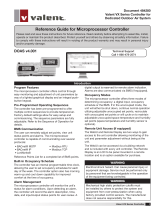
Johnson Controls
Start-Up & Operation Guide | 5586996-JSG-A-0120
5
Nomenclature
3: Combined Pre and Post Filter Transducer
and Combined Magnehelic Gauge
4: Separate Pre and Post Filter Transducer
and Magnehelic Gauge
5: Combined Pre and Post Filter Magnehelic
Gauge
6:
Separate Pre and Post Filter Magnehelic
Gauge
7: Combined Pre and Post Filter Transducer,
Separate Pre and Post Filter Magnehelic
Gauge
Digit 15: Supply Fan
A: Direct Drive Plenum (DDP) Supply Fan with
1-inch Spring Isolation
B: DDP Supply Fan with 2-inch Spring Isolation
C: DDP Supply Fan with 2-inch Spring Isola-
tion and Seismic Restraint
Digit 16: Supply Fan Motor
Horsepower
A: 5 HP
B: 7.5 HP
C: 10 HP
Digit 17: Supply Fan Motor Type
2: ODP Premium Efficiency 1,800 RPM
4: TEFC Premium Efficiency 1,800 RPM
Digit 18: Supply Fan Options
0: None
1: Inlet Guard
2: Airflow Measurement Station
3: Shaft Grounding Ring
4: Inlet Guard and Airflow Measurement
Station
5: Inlet Guard and Shaft Grounding Ring
6: Airflow Measurement Station and Shaft
Grounding Ring
7: Shaft Grounding Ring, Inlet Guard and
Airflow Measurement Station
Digits 19: Building Pressure
Control
0: None
1: Barometric Damper
2: Exhaust with VFD and Backdraft Damper
3: Modulating Damper (On/Off Exhaust Fan
Only without VFD)
4:
Modulating Damper (Return Fan Only with
VFD)
Digit 20: Return/Exhaust Fan
A: None
B: Exhaust Fan with 1-inch Spring Isolation
C: Exhaust Fan with 2-inch Spring Isolation
D: Exhaust Fan with 2-inch Spring Isolation
and Seismic Restraint
E: Return Fan with 1-inch Spring Isolation
F: Return Fan with 2-inch Spring Isolation
G: Return Fan with 2-inch Spring Isolation and
Seismic Restraint
Digit 21: Return/Exhaust Fan
Motor Horsepower
A: None
E: 3 HP
F: 5 HP
G: 7.5 HP
H: 10 HP
J: 15 HP
K: 20 HP
Digit 22: Return/Exhaust Fan
Motor Type
0: None
2: ODP Premium Efficiency 1,800 RPM
4: TEFC Premium Efficiency 1,800 RPM
Digit 23: Return/Exhaust Fan
Options
A: None
B: Shaft Grounding Ring
C: Extended Grease Lines
D:
Extended Grease Lines and Shaft Ground-
ing Ring
E: Belt Guards
F: Belt Guards and Shaft Grounding Ring
G: Return Fan Airflow Measurement Station
H: Return Fan Airflow Measurement Station
and Shaft Grounding Ring
J: Extended Grease Lines and Belt Guards
K: Extended Grease Lines and Belt Guards
and Shaft Grounding Ring
L: Extended Grease Lines and Return Fan
Airflow Measurement Station
M: Extended Grease Lines and Return Fan
Airflow Measurement Station and Shaft
Grounding
N: Belt Guards and Return Fan Airflow Mea-
surement Station
P: Belt Guards and Return Fan Airflow
Measurement Station and Shaft Ground-
ing Ring
Q: Extended Grease Lines and Belt Guards
and Return Fan Airflow Measurement
Station
R: Extended Grease Lines and Belt Guards
and Return Fan Airflow Measurement
Station and Shaft Grounding Ring
Digits 24: Return/Exhaust Fan
Drive
A: None
B–K: RPM
Digit 25: Evaporator Options
G: Aluminum Fin Evaporator with SST Drain
Pan
H: Aluminum Fin Evaporator with SST Drain
Pan with Condensate Overflow Switch
J: E-Coat Aluminum Fin Evaporator with SST
Drain Pan
K: E-Coat Aluminum Fin Evaporator with
SST Drain Pan with Condensate Overflow
Switch
L: Copper Fin Evaporator with SST Drain Pan
M: Copper Fin Evaporator with SST Drain
Pan with Condensate Overflow Switch
Digit 26: Condenser Coil Options
2: With Wire Guards
3: Full Louvered Panels
4: Partial Louvered Panels with Wire Guards
6: E-Coat Condenser with Wire Guards
7: E-Coat Condenser, Full Louvered Panels
8: E-Coat Condenser, Partial Louvered
Panels with Wire Guards
Digit 27: Draw-Thru Filter Options
A: Angled Filter Rack, No Filters
B: Angled Filter Rack, 2-Inch Throwaway
Filters
C: Angled Filter Rack, 2-Inch MERV 8 Filters
D: Rigid Filter Rack, No Filters
E: Rigid Filter Rack, MERV 15 Bag Filters
with 2-Inch MERV 8 Pre-Filters
F: Rigid Filter Rack, MERV 14 Rigid Filters
with 2-Inch MERV 8 Pre-Filters
G: Vertical Filter Rack, No Filters
H: Vertical Filter Rack, 4-Inch MERV 8 Filters
Digit 28: Draw-Thru Filter Control
Options
0: None
1: Combined Pre and Post Filter Transducer
2: Separate Pre and Post Filter Transducer
3: Combined Pre and Post Filter Transducer
and Combined Magnehelic Gauge
4: Separate Pre and Post Filter Transducer
and Magnehelic Gauge
5: Combined Pre and Post Filter Magnehelic
Gauge
6:
Separate Pre and Post Filter Magnehelic
Gauge
7: Combined Pre and Post Filter Transducer,
Separate Pre and Post Filter Magnehelic
Gauge
Digit 29: Economizer Options
A: None
C: Dry Bulb Economizer, Low Leak Dampers
D: Single Enthalpy Economizer, Low Leak
Dampers
E:
Dual Enthalpy Economizer, Low Leak
Dampers
F: Dry Bulb Economizer, Low Leak Dampers
with Airflow Measurement Station
G: Single Enthalpy Economizer, Low Leak
Dampers with Airflow Measurement Station
H: Dual Enthalpy Economizer, Low Leak
Dampers with Airflow Measurement Station
K: Dry Bulb Economizer, Ultra Low Leak
Dampers
L: Single Enthalpy Economizer, Ultra Low
Leak Dampers
S: Dual Enthalpy Economizer, Ultra Low Leak
Dampers
T: Dry Bulb Economizer, Ultra Low Leak
Dampers with Airflow Measurement Station
U: Single Enthalpy Economizer, Ultra Low
Leak Dampers with Airflow Measurement
Station
V: Dual Enthalpy Economizer, Ultra Low
Leak Dampers with Airflow Measurement
Station
Digit 30: Energy Recovery
Options
0: None
1: Low CFM Energy Recovery Wheel (ERW)
without VFD
2: Low CFM ERW with VFD
3: High CFM ERW without VFD
4: High CFM ERW with VFD
Digit 31: Refrigeration System
Piping Options
A: None
B: Suction and Discharge Valves
C: Suction, Discharge, and Liquid Valves
D: Suction, Discharge, and Liquid Valves with
Replaceable Core Filter Driers
E: Hot Gas Reheat (HGRH)
F: Suction and Discharge Valves with HGRH
G: Suction, Discharge, and Liquid Valves with
HGRH
D: 15 HP
E: 20 HP
F: 25 HP
G: 30 HP
H: 40 HP
J: 50 HP





















